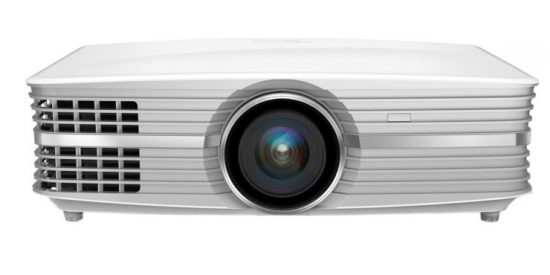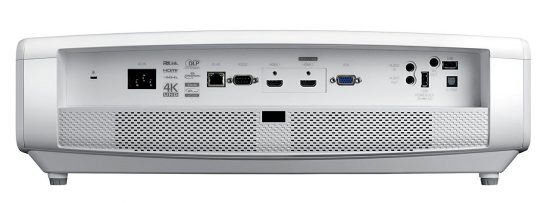Review: Optoma UHD60 4K Ultra HD Projector
4K. We’ve all heard of it. Some of you will have seen 4K films in the cinema, others will have 4K TVs, and a few will have seen 4K on a projector in your own home. The latter has proven to be a rather expensive purchase, but prices are gradually coming down and the Optoma UHD60 4K projector is moving in the right direction.
I was lucky enough to test it out when Optoma sent one over.
First things first, previous projectors have been gradually getting smaller over the past few years. However, the UHD60 is bigger than them. The dimensions are W490 x H141 x D331mm so you need to make sure that it will fit in the place you plan on having it. Despite its size, it does look good. All white with some silver trim and the lens is bang in the centre.
The construction is all solid. The top panel flips up so you can get to the lamp access hatch, the zoom control lever and a wheel to shift the image. I did feel that the panel was a little on the flimsy side and it did not always click closed, but you don’t really see that when watching a film so it is easy to live with.
As with all Optoma projectors, it is extremely easy to set up. Plug it in. Connect your media player of choice (ensuring that is connected to the relevant sound system) and away you go. Initially, I did have a problem with the projector losing the image and resetting itself, but that was due to the fact I was using an older HDMI cable. Using one of the newer HDMI cables it was all sorted.
The unit does have a number of connections at the back. They include two HDMIs (the HDMI2 socket can deal with4K, HDR and MHL 2.1), a VGA PC port, a powered USB port, a 12V trigger out, RS-232 and RJ45 ports and audio jacks for the built-in sound system.
Using the vertical image shifting wheel along with the easy to use menu system I soon had the image perfectly centred on the screen. Having all the options for the image size means you can place the projector where you want it.
As you would expect the image is incredible, even when not in 4K. The projector is said to have a dynamic contrast ratio of 1,000,000:1 and a high maximum brightness of 3000 ANSI Lumens.
With over eight million pixels, Ultra HD 4K resolution brings four times more detail than Full HD, to deliver sharper, life-like images and richer colours. All well and good, but is that something you really notice? Damn right you do. When watching something in 4K it is simply stunning. Almost like a window to the world outside. Hooking up my PC to the projector I watched some of the 4K nature videos on YouTube and you feel like you could step into the scenes. It is impossible to describe in the written word the step up 4K gives you when compared to the current HD images. You just need to try and experience it for yourself.
Then there were 4K Blu-rays of The Thing and Blood Simple which looked stunning. The Thing has always looked good on Blu-ray, but the new 4K restoration is absolutely incredible. It looks like the film was made yesterday. The same with Blood Simple. I honestly did not think 4K would make much difference to the older films, but it was amazing.
Now if you were going to compare the 4K picture to the top of the line 4K TV then that would probably have the better picture quality, but then you are not going to get the image size that you would with a projector.
The UHD60 supports the HDR10 format, but not the HLG (Hybrid Log-Gamma) or Dolby Vision HDR formats. The is also an HDR picture preset in the projector options.
To get the best image possible you will have to work with the various settings – Dynamic Black, Bright Lamp setting, contrast, white balance, colours etc – until you get the perfect image that works for you. However, the various preset options will get you something that will work well initially.
There were some rainbowing moments (when you see the strips of red, blue and green) on very bright images, but they were minor and extremely brief.
Once you get it set up to your liking you will find the images are rich, balanced, sharp and dynamic. The projector can deal with fast-moving images without thing becoming blurry. Playing video games was a delight with the processor having no problem keeping up with the fast gameplay ensuring a high-quality gaming experience.
Watching standard definition films was also great. The UHD60 also offers SDR to HDR conversion. This unique feature lets you enjoy near-HDR content from any standard source – providing enhanced contrast, detail and colours to all SDR content. On the whole that worked well, but for some films on DVD, it did result in some pixelation and loss of detail.
As for the inbuilt sound system. As with all projectors that have the feature, it is good that it is there as a backup, but you are never really going to use it and the speakers just don’t have enough power to give it a decent punch. Let’s be honest, if you are going to be buying a projector you are getting it for the visual side of things. Obviously, you will play the sound through a surround sound system or soundbar.
While still not exactly cheap this is one of the more affordable 4K projectors currently on the market and it is well worth checking out if you are considering moving to 4K. You could spend a lot more money on a different 4K projector and still end up with the same results.
I was very impressed with the UHD60 and it produced some stunning images.
Specifications:
| Display Technology | DLP |
| Resolution | UHD (3840×2160) |
| Brightness1 (Bright Mode) | 3000 ANSI Lumens |
| Contrast | 1,000,000:1 |
| Typical lamp life2 Dynamic/Eco/Bright | 15000/10000/4000 (hrs) |
| Throw Ratio 3 | 1.39 – 2.22:1 |
| Zoom Type | 1.6x Manual |
| Lens Shift | Vertical: +15% |
| I/O Connectors | HDMI 2.0, HDMI, VGA (RGB/YPbPr), Audio in 3.5mm, Audio out S/PDIF, Audio Out 3.5mm, RJ45, RS232, USB-A Power (1.5A), USB service, 12V trigger |
| Speaker (Watts) | 2x 4 |
| Weight (kg) | 7.8 |
| Dimensions (W x D x H) (mm) | 498 x 331 x 141 |
| Aspect Ratio | 16:9 Native, 4:3 Compatible |
| Projection Screen Size | 0.67 – 7.68m (26.45″ – 302.2″) Diagonal 16:9 |
| Projection Distance | 1.3 – 9.3m |
| Projection Lens | F/2.5~3.26; f=20.91~32.62mm |
| Uniformity | 85% |
| Maximum Resolution | 2160p |
| Computer Compatibility | UHD, WQHD, WUXGA, FHD, UXGA, SXGA, WXGA, HD, XGA, SVGA, VGA, Mac |
| Video Compatibility | 480i/p, 576i/p, 720p(50/60Hz), 1080i(50/60Hz), 1080p(24/50/60Hz), 2160p(24/50/60Hz) |
| Input Lag (ms) | 55 |
| Horizontal Scan Rate | 31~135KHz |
| Vertical Scan Rate | 24~120 Hz |
| Displayable Colours | 1073.4 Million |
| Noise Level (Eco mode) | 25dB |
| Power Supply | Input: 110 – 220v |
| Power Consumption | 305W Bright mode / 249W Eco mode (< 0.5W Standby) |
| Lamp Type | 240W |
| Operating Conditions | 5°C – 40°C, Max. Humidity 85%, Max. Altitude 3000m |
| Security | Security bar, Kensington lock |
| On Screen Display | 10 Languages: English, Español, Français, Deutsch, Português, Italiano, Русский, 簡体中文, 日本語, 한국어 |
| Standard Accessories | AC power cord, remote control, 2x AA batteries, Basic user manual |
| Optional Accessories | Ceiling mount |
| Optional Wireless | No |
| Warranty | 3 Years |
| RoHS | Compliant |












